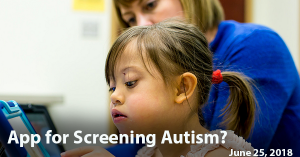Check out other stories from the Latest News
Face-recording App May Screen for Autism
By Chelsea Toledo, M.A. on June 25, 2018

Background: Recent years have seen a huge surge in the number of apps created for Autism Spectrum Disorder (ASD), with the current number in the Apple app store topping 1,000. Many of these apps are aimed at instilling academic and functional skills in individuals with ASD. Others help users find support and services or provide news and raise awareness about ASD.
What’s New: A new study explored the use of an app for screening children with ASD. The researchers developed an iPhone app to detect differences in emotions and attentiveness – two areas affected in ASD. The app recorded the reactions of children as they watched movies on an iPhone, and then coded their behaviors. In all, 1,756 families with children between the ages of 1 and 6 years old participated over the course of a year, resulting in 4,441 videos of children in their natural settings. In addition, 5,618 demographic surveys were received from caregivers.
The researchers found:
- 32 percent of the participants were high risk for ASD, as defined by either having a caregiver report an ASD diagnosis having a high score on the M-CHAT ASD screening.
- Video clips - which included bubbles, bunnies, mirrors, and toys and songs - were each watched by more than half of the participants.
- Girls who were high risk for ASD demonstrated significantly less attention to the videos on bubbles, bunnies, and mirrors than girls who were low risk for ASD. This association was not the same for boys.
- Children with high M-CHAT scores were less likely to have positive emotional reactions to the bubbles movie than their peers with lower scores.
Why it’s important: This study suggests that app-based method could one day be leveraged to help screen for ASD in children. Because the screening would take place in children’s home environments, the results could be more meaningful than in-office interactions.
Image Credit: Kaethe Richter Henning, University of New Mexico, downloaded from the NIH Image Gallery under a Creative Commons license
Help me understand :
| Source(s) : |
| Tweet |

